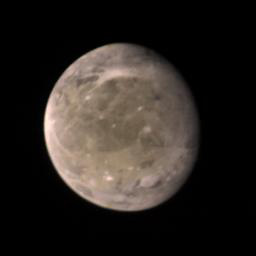Click on image for full size
Courtesy of NASA
Related links:
Dust Around Moon Gives Clues to Planetary Rings
News story originally written on June 17, 1999
With the help of Galileo, scientists have discovered new evidence that may explain planetary rings like those of the planet Jupiter. We already know the rings are made of dust and ice. However, until now scientists only had guesses as to how the rings actually formed.
Galileo has found small grains of dust that are always bombarding celestial bodies. When the high speed particles hit the surface, they throw pieces of debris up into space. Smaller bodies, such as moons, have a gravity just strong enough to hold the particles in orbit. Eventually, the grains form a ring.
The research was conducted while studying Ganymede, the largest of Jupiter's 15 moons. Using a small metal can, scientists could measure the velocities of the meteoroids when they hit the moon. They then calculated the direction and the mass of the particles.
"Each of the satellites in the solar system are pummeled by interplanetary dust particles, or meteoroids which are marble-sized or millimeter-sized objects," said Galileo scientist Douglas Hamilton, a University of Maryland astronomer. "When those hit a satellite, or moon, at high speeds, they slam into the surface and blast a crater, and all sorts of particles fly off. That's what is happening at Ganymede, and we think that's what's happening at all the satellites in the solar system."
Unfortunately, this new study fails to shed any light on the formation of Saturn's rings, which are made of big chunks of ice. However, we may now have an explanation for the average dust clouds surrounding planets and moons in our solar system.















